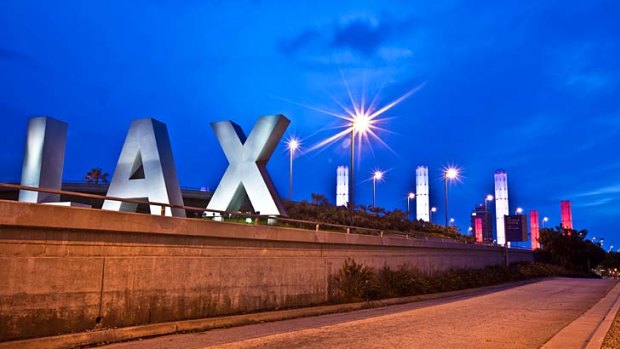
Blast from the past ... the Century Boulevard airport entrance.Credit: Alamy
Los Angeles airport is getting a much-needed makeover, writes Lance Richardson.
In the centre of Los Angeles International Airport is a distinctive circular building, something that looks akin to a flying saucer with arches soaring over the top. Called the Theme Building, it houses a restaurant called Encounter, with retro-looking Formica tables, lava lamps and psychedelic mosaic work in the bathrooms. It has often been likened to something from The Jetsons.
Though Encounter has appeal, the surrounding airport can sometimes seem retro in a more negative sense - more Flintstones than fantasy space age, with glacial-pace queues and outdated infrastructure. The airport's media and public relations managing director, Mary Grady, pauses for a moment when I ask her about Los Angeles International's deficiencies.
"I'm going to speak as a consumer," she says. "I think all of us who live in Los Angeles and have used that airport for years could see it - I don't want to say falling apart, but slowly needing some TLC."
This should come as no surprise to Australian travellers, of whom an estimated 383,000 passed through the airport last year. Australians stayed for an average of six nights in the city. These figures are expected to grow this year.
Changes are in the works, however, and to some extent they've already begun to noticeably alter the "visitor experience".
"There were some very serious challenges to anything being done," Grady says, meaning communities living and working on either side of the airport didn't want further expansion and fought modernisation measures until a new mayor managed to broker an agreement.
Terminal 6, now home to Alaska Airlines, finished a $US238 million upgrade in March, installing self-service check-ins, additional security checkpoints and a new baggage-handling system. Terminal 5, home to Delta Airlines, which flies to Australia, is following suit, undergoing a $US228 million upgrade focused on customer service, energy efficiency and passenger-processing facilities. It is expected to be finished in 2015.
The biggest changes can be found in the Tom Bradley International Terminal, which had $US737 million of upgrades completed in 2010, including interior renovations and, importantly, digital signs that automatically refresh flight information. Keeping in line with the city's Public Percent for Art Program, the renovation involved 17 teams of artists who were commissioned to create video works about the airport and LA itself.
Then there's the airport's new connecting terminal, so vast in scope that it earned the title of "largest public works project in city history".
Los Angeles airport has experienced four epochal shifts: in the 1920s, the city buys land and opens its first terminal; in the 1950s, the airport expands to embrace the jet age; the 1980s brought the first Tom Bradley terminal, built in response to an exponential growth of international travel. Now we have A380 planes criss-crossing the skies, but just two gates at Los Angeles are equipped to accommodate such a big aircraft. Of four A380 flights a day, two belong to Qantas.
The New Tom Bradley International Terminal cost $US1.7 billion and is slated to open, in part, in April next year. The new terminal roof looks like a line of crashing waves and there will be 18 new gates, nine of which are designed to service new-generation aircraft such as the A380.
The statistics include almost unfathomable numbers: enough steel to build 22,206 (American) midsize cars; enough glass to create a window the size of 6½ football fields; and space to accommodate 4000 passengers every hour. Having walked through the terminal's Great Hall, where a computerised clock tower will evoke the atmosphere of a grand station, I can attest to the staggering size of the project (see lawa.org).
Perhaps most immediately notable, however, is what Grady calls "putting LA back in LAX". On every trip made, an average passenger spends several hours at the airport. Stopovers, fewer seats and regular delays are becoming the norm in the US aviation industry.
"People need some creature comforts," Grady says. To this end, more than 60 dining and shopping outlets will open this year, including a Kitson boutique, and Skewers, a restaurant from Iron Chef Masaharu Morimoto.
"If you're in LA, why not make it feel like LA?" Grady says. From the new Bradley terminal, on a clear day, you can even see the Hollywood sign.
Lance Richardson travelled courtesy of the Los Angeles Tourism & Convention Board.
Sign up for the Traveller Deals newsletter
Get exclusive travel deals delivered straight to your inbox. Sign up now.